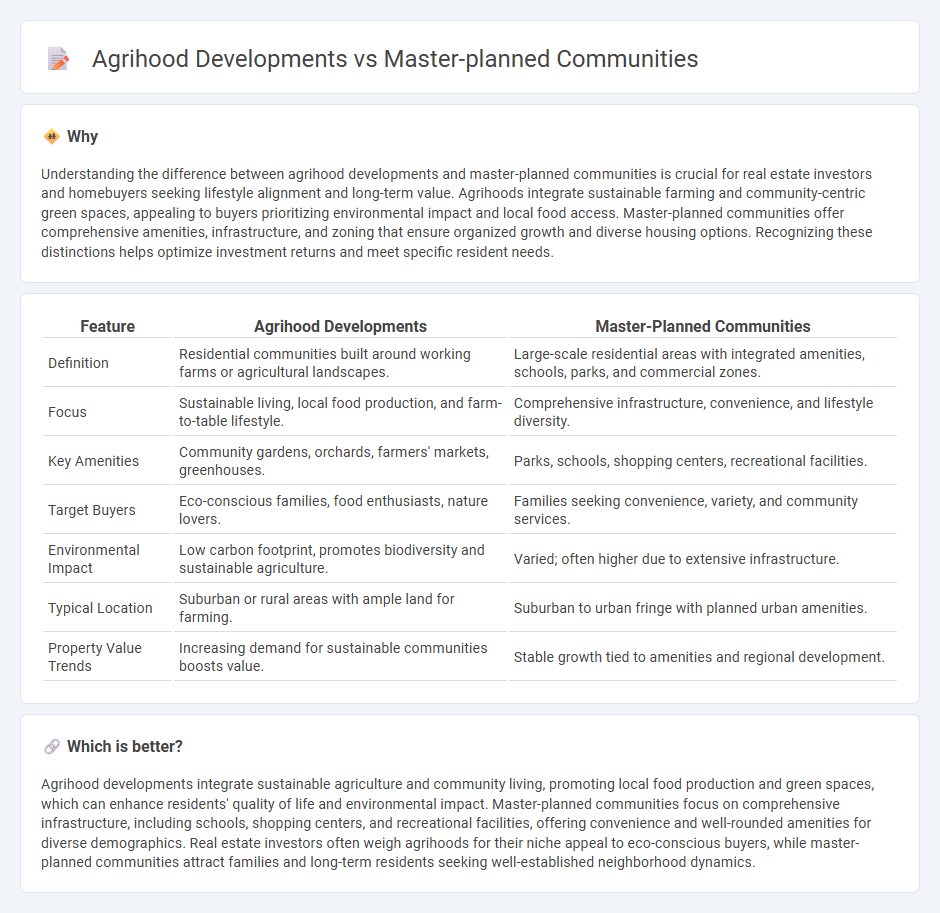
Agrihood developments integrate sustainable farming practices and community gardens into residential layouts, promoting local food production and eco-friendly living. Master-planned communities offer comprehensive amenities, including schools, shopping centers, and recreational facilities, designed for convenience and modern lifestyles. Explore the distinct benefits and lifestyle features of agrihoods and master-planned communities to find your ideal home environment.
Why it is important
Understanding the difference between agrihood developments and master-planned communities is crucial for real estate investors and homebuyers seeking lifestyle alignment and long-term value. Agrihoods integrate sustainable farming and community-centric green spaces, appealing to buyers prioritizing environmental impact and local food access. Master-planned communities offer comprehensive amenities, infrastructure, and zoning that ensure organized growth and diverse housing options. Recognizing these distinctions helps optimize investment returns and meet specific resident needs.
Comparison Table
| Feature | Agrihood Developments | Master-Planned Communities |
|---|---|---|
| Definition | Residential communities built around working farms or agricultural landscapes. | Large-scale residential areas with integrated amenities, schools, parks, and commercial zones. |
| Focus | Sustainable living, local food production, and farm-to-table lifestyle. | Comprehensive infrastructure, convenience, and lifestyle diversity. |
| Key Amenities | Community gardens, orchards, farmers' markets, greenhouses. | Parks, schools, shopping centers, recreational facilities. |
| Target Buyers | Eco-conscious families, food enthusiasts, nature lovers. | Families seeking convenience, variety, and community services. |
| Environmental Impact | Low carbon footprint, promotes biodiversity and sustainable agriculture. | Varied; often higher due to extensive infrastructure. |
| Typical Location | Suburban or rural areas with ample land for farming. | Suburban to urban fringe with planned urban amenities. |
| Property Value Trends | Increasing demand for sustainable communities boosts value. | Stable growth tied to amenities and regional development. |
Which is better?
Agrihood developments integrate sustainable agriculture and community living, promoting local food production and green spaces, which can enhance residents' quality of life and environmental impact. Master-planned communities focus on comprehensive infrastructure, including schools, shopping centers, and recreational facilities, offering convenience and well-rounded amenities for diverse demographics. Real estate investors often weigh agrihoods for their niche appeal to eco-conscious buyers, while master-planned communities attract families and long-term residents seeking well-established neighborhood dynamics.
Connection
Agrihood developments and master-planned communities are interconnected through their focus on integrating sustainable living with communal amenities and green spaces. Both concepts prioritize walkability, local food production, and environmentally conscious design to enhance residents' quality of life and promote community engagement. These synergistic elements foster healthier lifestyles and bolster property values by creating cohesive, vibrant neighborhoods centered around agriculture and thoughtful urban planning.
Key Terms
Zoning
Master-planned communities typically emphasize mixed-use zoning, integrating residential, commercial, and recreational spaces to create cohesive neighborhoods with diverse amenities. Agrihood developments prioritize agricultural zoning, dedicating substantial land to sustainable farming, community gardens, and green spaces that promote local food production and environmental stewardship. Explore how zoning regulations shape community design and lifestyle by delving deeper into master-planned and agrihood development models.
Community Amenities
Master-planned communities offer extensive amenities such as swimming pools, fitness centers, golf courses, and clubhouses designed to cater to a broad range of recreational and social activities. Agrihood developments prioritize farm-to-table experiences with community gardens, orchards, and farmers' markets, fostering a connection to sustainable agriculture and local food production. Explore more to understand how these diverse amenities impact lifestyle and community engagement.
Land Use Planning
Master-planned communities emphasize comprehensive land use planning that integrates residential, commercial, and recreational spaces to create balanced urban environments. Agrihood developments prioritize sustainable land use by incorporating agricultural elements like community farms, green spaces, and local food production into residential planning. Explore the unique land use strategies that define these innovative community designs.
Source and External Links
The Top-Selling Master-Planned Communities of 2024 - Presents RCLCO's list highlighting the top-selling master-planned communities in 2024, emphasizing comprehensive planning and community features.
Best Master Planned Communities for Retirees - Offers a look at master-planned communities tailored for retirees, focusing on luxury, comfort, and active living with various amenities.
Top 50 Master-Planned Communities 2024 Rankings - Provides insights into the top 50 master-planned communities in 2024, highlighting stable sales and desirable lifestyles despite market challenges.
 dowidth.com
dowidth.com